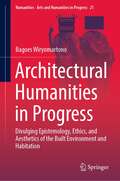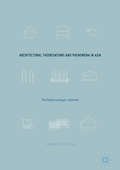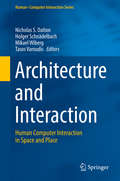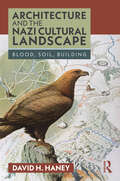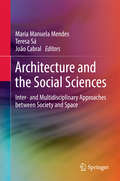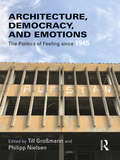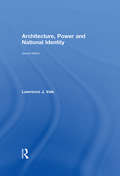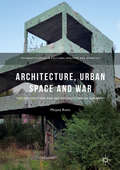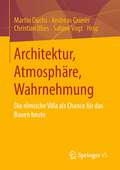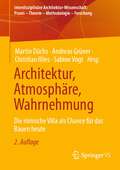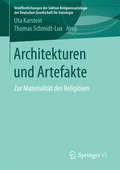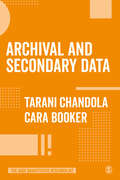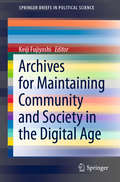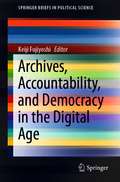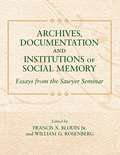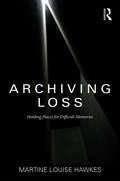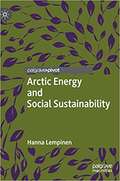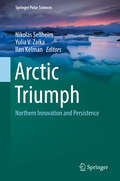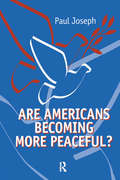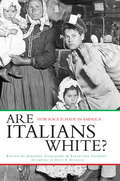- Table View
- List View
Architectural Humanities in Progress: Divulging Epistemology, Ethics, and Aesthetics of the Built Environment and Habitation (Numanities - Arts and Humanities in Progress #21)
by Bagoes WiryomartonoThis monograph brings three branches of philosophy together: epistemology, ethics and aesthetics. It assesses the built environment as a case study from a phenomenological perspective. Under the notion of phenomenology, this study understands the built environment as the hermeneutical phenomenon of being in the life-world that is experienced by people within the socio-cultural and historical context of habitation. Hermeneutically, the built environment as a phenomenon is contextually interwoven with other phenomena within the socio-cultural, historical, and environmental network. Phenomenologically speaking, the task of the study is to excavate, listen to, unfold, divulge, and reconstruct the socio-culturally, environmentally, and historically constructed relationship between people and their built environment that build, develop, and elaborate the system of knowledge, ethics, and aesthetics. By and large, its nature and findings are theoretical and interdisciplinary, so it will be of interest not only for philosophers, but also to scholars studying urban development and anthropology.
Architectural Theorisations and Phenomena in Asia: The Polychronotypic Jetztzeit
by Francis Chia-Hui LinThis book is the first overall and detailed discussion of contemporary Asia's architectural theorisations and phenomena based on its heteroglossic and decolonisation character. Lin presents a theoretical journey of transdisciplinary reflection upon contemporary Asia's pragmatic phenomena which is methodologically achieved by means of elaborations of how tangible Asian architecture can be philosophically theorised and how interchangeable architectural theory is practically 'Asianised'. Discussions in the book are critically integrated with comparative studies focused on Japan, Taiwan, China, Hong Kong, Singapore, Malaysia, Australia, New Zealand and the UK. These empirical examinations are highlights of phenomenal localities, architecture, cities and cultures which reference the historicity of the Asia Pacific, Asia's contemporary architectural situations, and their subtle relationship with the 'West'. The schematisation of intended 'fuzziness' for Asia and its architecture is framed as the notion polychronotypic jetztzeit to represent a present time-place context of contemporary Asian architecture and urbanism. This book will be of great interest to scholars of Asian Studies, Architectural Studies, Postcolonial Studies, Urban Studies and Cultural Studies.
Architecture and Interaction: Human Computer Interaction in Space and Place (Human–Computer Interaction Series #0)
by Mikael Wiberg Nicholas S. Dalton Holger Schnädelbach Tasos VaroudisUbiquitouscomputing has a vision of information and interaction being embedded in theworld around us; this forms the basis of this book. Built environments aresubjects of design and architects have seen digital elements incorporated intothe fabric of buildings as a way of creating environments that meet the dynamicchallenges of future habitation. Methods forprototyping interactive buildings are discussed and the theoretical overlapsbetween both domains are explored. Topics like the role of space and technologywithin the workplace as well as the role of embodiment in understanding howbuildings and technology can influence action are discussed, as well as investigating the creation of place with new methodologies toinvestigate the occupation of buildings and how they can be used to understandspatial technologies. Architectureand Interaction is aimed at researchers and practitioners in the field of computing who want togain a greater insight into the challenges of creating technologies in thebuilt environment and those from the architectural and urban design disciplineswho wish to incorporate digital information technologies in future buildings.
Architecture and Leadership: The Nature and Role of Space and Place in Organizational Culture (Leadership Horizons)
by Mark A. Roberson Alicia D. CrumptonFrom cathedrals to cubicles, people go to great lengths and expense to design their living and working environments. They want their spaces to be places where they enjoy being, reflecting who they are and what they care about. The resultant environments in turn become loud, albeit unvocal, leaders for people occupying those corresponding spaces. The design and use of work and living spaces typifies and thematizes expectations for the group. Essentially, the architecture of rooms, buildings and cities creates cultures by conveying explicit and implicit messages. This is evident when people approach and walk into St. Basil’s Cathedral in Moscow, the Forbidden City in Beijing, the Sydney Opera House in Sydney, Australia, the Jewish Museum in Berlin, or the Rothko Chapel in Houston, to name some examples. While leaders oftentimes lack the resources to have their spaces mirror the greatest architectural achievements of the world, they are in a position to use the art and science of architecture, at whatever scale is available, to their advantage. The creative and intentional use of space and place advances and promotes cherished values and enhances organizational effectiveness. This book explores the essence of good architecture and establishes relevant connections for leaders and managers to strategically design and use the organizational workplace and space to support their mission and purpose, and create aesthetically meaningful work environments. It equips leaders to be culturally astute on what defines good architecture and to incorporate principles of beauty in their leadership practices accordingly and will be of interest to researchers, academics, professionals, and students in the fields of leadership, organizational studies, and architecture theory and practice.
Architecture and the Nazi Cultural Landscape: Blood, Soil, Building
by David H. HaneyThis book traces cultural landscape as the manifestation of the state and national community under the Nazi regime, and how the Nazi era produced what could be referred to as a totalitarian cultural landscape. For the Nazi regime, cultural landscape was indeed a heritage resource, but it was much more than that: cultural landscape was the nation. The project of Nazi racial purification and cultural renewal demanded the physical reshaping and reconceptualization of the existing environment to create the so-called "new Nazi cultural landscape." One of the most important components of this was a set of monumental sites thought to embody blood and soil beliefs through the harmonious synthesis of architecture and landscape. This special group of "landscape-bound" architectural complexes was interconnected by the new autobahn highway system, itself thought to be a monumental work embedded in nature. Behind this intentionally aestheticized view of the nation as cultural landscape lay the all-pervasive system of deception and violence that characterized the emerging totalitarian state. This is the first historical study to consider the importance of these monumental sites together with the autobahn as evidence of key Nazi cultural and geographic strategies during the pre-war years. This book concludes by examining racial and nationalistic themes underlying cultural landscape concepts today, against this historic background.
Architecture and the Nazi Cultural Landscape: Blood, Soil, Building
by David H. HaneyThis book traces cultural landscape as the manifestation of the state and national community under the Nazi regime, and how the Nazi era produced what could be referred to as a totalitarian cultural landscape.For the Nazi regime, cultural landscape was indeed a heritage resource, but it was much more than that: cultural landscape was the nation. The project of Nazi racial purification and cultural renewal demanded the physical reshaping and reconceptualization of the existing environment to create the so-called "new Nazi cultural landscape." One of the most important components of this was a set of monumental sites thought to embody blood and soil beliefs through the harmonious synthesis of architecture and landscape. This special group of "landscape-bound" architectural complexes was interconnected by the new autobahn highway system, itself thought to be a monumental work embedded in nature. Behind this intentionally aestheticized view of the nation as cultural landscape lay the all-pervasive system of deception and violence that characterized the emerging totalitarian state.This is the first historical study to consider the importance of these monumental sites together with the autobahn as evidence of key Nazi cultural and geographic strategies during the pre-war years. This book concludes by examining racial and nationalistic themes underlying cultural landscape concepts today, against this historic background.
Architecture and the Social Sciences: Inter- and Multidisciplinary Approaches between Society and Space
by Maria Manuela Mendes Teresa Sá João CabralThis book contributes to current debates on the relationship between architecture and the social sciences, highlighting current interdisciplinary and transdisciplinary teaching as well as research and practice in architecture and urbanism. It also raises awareness about the complementarities and tensions between the spaces of the project, including the construction spaces and living space. It gives voice to recent projects and socio-territorial interventions, focusing on interdisciplinary and multidisciplinary approaches between society and space. Divided into two parts, the first part discusses the possible dialogue between social sciences and architecture, while the second part explores architecture, politics and social change in urban territories from a European perspective.
Architecture, Democracy and Emotions: The Politics of Feeling since 1945
by Till Großmann Philipp NielsenAfter 1945 it was not just Europe’s parliamentary buildings that promised to house democracy: hotels in Turkey and Dutch shopping malls proposed new democratic attitudes and feelings. Housing programs in the United Kingdom, the United States, and the Soviet Union were designed with the aim of creating new social relations among citizens and thus better, more equal societies. Architecture, Democracy, and Emotions focuses on these competing promises of consumer democracy, welfare democracy, and socialist democracy. Spanning from Turkey across Eastern and Western Europe to the United States, the chapters investigate the emotional politics of housing and representation during the height of the Cold War, as well as its aftermath post-1989. The book assembles detailed research on how the claims and aspirations of being "democratic" influenced the affects of architecture, and how these claims politicized space. Architecture, Democracy, and Emotions contributes to the study of Europe’s "democratic age" beyond Cold War divisions without diminishing political differences. The combination of an emotional history of democracy with an architectural history of emotions distinguishes the book’s approach from other recent investigations into the interconnection of mind, body, and space.
Architecture, Power and National Identity
by Lawrence ValeThe first edition of Architecture, Power, and National Identity, published in 1992, has become a classic, winning the prestigious Spiro Kostof award for the best book in architecture and urbanism. Lawrence Vale fully has fully updated the book, which focuses on the relationship between the design of national capitals across the world and the formation of national identity in modernity. Tied to this, it explains the role that architecture and planning play in the forceful assertion of state power. The book is truly international in scope, looking at capital cities in the United States, India, Brazil, Sri Lanka, Kuwait, Bangladesh, and Papua New Guinea.
Architecture, Urban Space and War: The Destruction and Reconstruction of Sarajevo (Palgrave Studies in Cultural Heritage and Conflict)
by Mirjana RisticThis book investigates architectural and urban dimensions of the ethnic-nationalist conflict in Sarajevo, the capital of Bosnia and Herzegovina, during and after the siege of 1992–1995. Focusing on the wartime destruction of a portion of the cityscape in central Sarajevo and its post-war reconstruction, re-inscription and memorialization, the book reveals how such spatial transformations become complicit in the struggle for reconfiguration of the city’s territory, boundaries and place identity. Drawing on original research, the study highlights the capacities of architecture and urban space to mediate terror, violence and resistance, and to deal with heritage of the war and act a catalyst for ethnic segregation or reconciliation. Based on a multi-disciplinary methodological approach grounded in architectural and urban theory, the spatial turn in critical social theory and assemblage thinking, as well as techniques of spatial analysis, in particular morphological mapping, the book provides an innovative spatial framework for analyzing the political role of contemporary cities.
Architektur, Atmosphäre, Wahrnehmung: Die römische Villa als Chance für das Bauen heute
by Christian Illies Andreas Grüner Martin Düchs Sabine Vogt„Nach Rom Architekturstudenten zu schicken heißt, sie für ihr ganzes Leben zu ruinieren.“ (Le Corbusier 1922). Im Sinne dieses Verdikts hat sich die Architekturmoderne radikal von der klassizistischen Tradition abgewandt, in der die antike Baukunst als Schulung, Folie und Muster galt, indem man ihre Formen, Strukturen und Proportionen formalästhetisch analysierte und nachahmte. Doch gab es bereits in der Antike ein anderes Konzept von Architekturverständnis: das sinnliche Erleben von Raumsequenzen und die Gestaltung von Atmosphären. Vorgeführt wird uns ein solches Verständnis in Bauten wie der Villa Hadriana aber auch in den „Villenbriefen“ des römischen Senators Plinius d. J. (um 100 n. Chr.). Von Architekten wurden Letztere lebhaft diskutiert, bis die Moderne jede Beschäftigung mit der Antike „untersagte“.Der Band „Architektur, Atmosphäre, Wahrnehmung“ versammelt nun zehn Beiträge, die wieder alle –mehr oder weniger intensiv – als Ausgangsbasis die Villenbriefe nutzen, allerdings nicht, um mit ihnen einen formalästhetischen Zugriff auf die Antike wiederzubeleben, sondern, weil der von Plinius vorgeführte und in der Forschung bis dato vernachlässigte Blick auf die römische Villa unter dem Aspekt einer sequentiellen Sinnlichkeit eine „Chance für das Bauen heute“ ist.Im Ergebnis kann man festhalten: Egal ob man Architekturstudenten nach Rom schickt oder nicht – in jedem Fall sollte man sie Plinius lesen lassen.
Architektur, Atmosphäre, Wahrnehmung: Die römische Villa als Chance für das Bauen heute (Interdisziplinäre Architektur-Wissenschaft: Praxis – Theorie – Methodologie – Forschung)
by Christian Illies Andreas Grüner Martin Düchs Sabine Vogt„Nach Rom Architekturstudenten zu schicken heißt, sie für ihr ganzes Leben zu ruinieren.“ (Le Corbusier 1922). Im Sinne dieses Verdikts hat sich die Architekturmoderne radikal von der klassizistischen Tradition abgewandt, in der die antike Baukunst als Schulung, Folie und Muster galt, indem man ihre Formen, Strukturen und Proportionen formalästhetisch analysierte und nachahmte. Doch gab es bereits in der Antike ein anderes Konzept von Architekturverständnis: das sinnliche Erleben von Raumsequenzen und die Gestaltung von Atmosphären. Vorgeführt wird uns ein solches Verständnis in Bauten wie der Villa Hadriana aber auch in den „Villenbriefen“ des römischen Senators Plinius d. J. (um 100 n. Chr.). Von Architekten wurden Letztere lebhaft diskutiert, bis die Moderne jede Beschäftigung mit der Antike „untersagte“.Der Band „Architektur, Atmosphäre, Wahrnehmung“ versammelt nun zehn Beiträge, die wieder alle –mehr oder weniger intensiv – als Ausgangsbasis die Villenbriefe nutzen, allerdings nicht, um mit ihnen einen formalästhetischen Zugriff auf die Antike wiederzubeleben, sondern, weil der von Plinius vorgeführte und in der Forschung bis dato vernachlässigte Blick auf die römische Villa unter dem Aspekt einer sequentiellen Sinnlichkeit eine „Chance für das Bauen heute“ ist.Im Ergebnis kann man festhalten: Egal ob man Architekturstudenten nach Rom schickt oder nicht – in jedem Fall sollte man sie Plinius lesen lassen.
Architekturen und Artefakte: Zur Materialität des Religiösen (Veröffentlichungen der Sektion Religionssoziologie der Deutschen Gesellschaft für Soziologie)
by Thomas Schmidt-Lux Uta KarsteinIn der Soziologie ist seit längerer Zeit ein zunehmendes Interesse an Architektur und Artefakten beobachtbar. Dabei wird daran erinnert, dass nicht nur immaterielle Zeichen, Symbole und Repräsentationen des Sozialen existieren, sondern auch Orte, Stoffe und Dinge. Diesen wird eine wichtige Rolle im sozialen Geschehen zugesprochen: Materiales erscheint als Träger von Erinnerungskulturen, als sozialer Akteur, Heilsvermittler, Medium von Repräsentation - kurz: als Bedingung, Beschränkung und Instrument sozialer Praxis. Dies gilt auch in Bezug auf Religion. Dennoch hat die Perspektive noch kaum Eingang in die deutschsprachige Religionssoziologie gefunden. Dieser Band soll daher Anstoß sein für die Öffnung der Religionssoziologie in Richtung einer Soziologie des Materialen.
Archival and Secondary Data (The SAGE Quantitative Research Kit)
by Tarani Chandola Cara BookerData archives provide rich and expansive sources of information for researchers. This book highlights the utility of secondary data analyses whilst showing you how to select the right datasets for your study, and in turn get the most out of your research. Topics include: · Generating your research question · Selecting appropriate datasets and variables · Examining univariate, bivariate and multivariate associations · Visualisng your data with tables and graphs Part of The SAGE Quantitative Research Kit, this book boosts students with know-how and confidence, to help them succeed on their quantitative research journey.
Archival and Secondary Data (The SAGE Quantitative Research Kit)
by Tarani Chandola Cara BookerData archives provide rich and expansive sources of information for researchers. This book highlights the utility of secondary data analyses whilst showing you how to select the right datasets for your study, and in turn get the most out of your research. Topics include: · Generating your research question · Selecting appropriate datasets and variables · Examining univariate, bivariate and multivariate associations · Visualisng your data with tables and graphs Part of The SAGE Quantitative Research Kit, this book boosts students with know-how and confidence, to help them succeed on their quantitative research journey.
Archives for Maintaining Community and Society in the Digital Age (SpringerBriefs in Political Science)
by Keiji FujiyoshiThis book explores how a society accepts and utilizes a system of archives to improve the quality of people’s lives at each level of community, organization, and government. This is the first book that examines the political, economic, and social background that has prevented the development of archival systems in Japan in comparison with other societies of different cultures such as the United States, Romania, India, and Korea. An archival system is an indispensable tool to live in the present and create a future by sharing an understanding of the past. For that reason, this book considers what “respecting the past” means from the point of view that people experience in their workplace to reconcile tragic experiences such as conflict, injustice, or corruption. Then the book shows how a system of archives plays a significant role in a democratic society because it serves as a foundation of evidence-based decision making for a specific group or the public. Thus, this volume provides guidance for ways that a society can build a common understanding of the importance of sharing the past to maintain community and society.
Archives, Accountability, and Democracy in the Digital Age (SpringerBriefs in Political Science)
by Keiji FujiyoshiThis book is the first attempt to introduce the current status of archival practices in Japan as well as the basic views of the populace on making records accessible to English readers. In general, Japan has not paid sufficient attention to keeping and utilizing records except in the field of historical research. This book thus examines Japanese attitudes about history, records management, information acts, the status of archivists of the constitution, and genealogical research practices and a description of archives. Consequently, such investigations clarify how both private and public archives function or fail to do so in those spheres of Japanese society. In addition, this book presents the efforts in wartime record keeping in Australia, which is significantly different from how the Japanese deal with such records. This book therefore provides a clear and concrete picture of the status of current archival practices in Japan and the thinking that underlies them. On the basis of such examinations, this book enables readers to understand to what extent and how the past affects the present through archives, to recognize the importance of archives, and to respect the past in order to maintain and develop perspectives in people’s lives.
Archives, Documentation, and Institutions of Social Memory: Essays from the Sawyer Seminar
by William G. Rosenberg Francis X. BlouinAs sites of documentary preservation rooted in various national and social contexts, artifacts of culture, and places of uncovering, archives provide tangible evidence of memory for individuals, communities, and states, as well as defining memory institutionally within prevailing political systems and cultural norms. By assigning the prerogatives of record keeper to the archivist, whose acquisition policies, finding aids, and various institutionalized predilections mediate between scholarship and information, archives produce knowledge, legitimize political systems, and construct identities. Far from being mere repositories of data, archives actually embody the fragments of culture that endure as signifiers of who we are, and why. The essays in Archives, Documentation, and Institutions of Social Memory conceive of archives not simply as historical repositories but as a complex of structures, processes, and epistemologies situated at a critical point of the intersection between scholarship, cultural practices, politics, and technologies.
Archiving Loss: Holding Places for Difficult Memories
by Martine HawkesDrawing together many stories from the archives of difficult events and volatile histories, Archiving Loss: Holding Places for Difficult Memories asks how we might cut and walk a path for memory, loss, and silence in the archive. The difficult events discussed in this book include state responses to refugees, events of genocide, alongside other less documented pockets of trauma, violence, and loss. This book describes the archives whose language and logic have shaped our ways we remember and respond to difficult events and the ways in which we expect memory and loss to be coherent, credible, and lead to clear conclusions. In asking what is missing and what is found in the archives of difficult events this book argues for the necessity of looking more closely at other ways of remembering loss and archiving memory.
Arctic Energy and Social Sustainability
by Hanna Lempinen<p>In recent years the Arctic has become the focus of political, popular and scholarly debates around the future of our world’s Energy. Increasing consumption, dwindling reserves, climate warming and developing technologies are expected to push energy-related activities ever further into the previously inaccessible north. Within this framework, energy in the Arctic is predominantly understood as synonymous with oil and gas production for international exports; meanwhile, any social sustainability concerns associated with energy-related developments remain largely neglected or reduced to regional socioeconomic concerns. <p>Lempinen adopts an alternative approach, exploring how energy and its societal aspects are defined and debated in the context of the circumpolar north. Combining an in-depth conceptual discussion on energy and the social dimension of sustainability with an empirical focus on the scientific and political “truths” produced about energy and society in the Arctic energyscape, this book is an enlightening read for students, scholars and professionals interested in issues related to energy and society in the Arctic or beyond.</p>
Arctic Triumph: Northern Innovation and Persistence (Springer Polar Sciences)
by Ilan Kelman Nikolas Sellheim Yulia V. ZaikaThis book approaches the challenges the Arctic has faced and is facing through a lens of opportunity. Through pinpointed examples from and dealing with the Circumpolar North, the Arctic is depicted as a region where people and peoples have managed to endure despite significant challenges at hand. This book treats the ‘Arctic of disasters’ as an innovated narrative and asks how the ‘disaster pieces’ of Arctic discourse interact with the ability of Arctic peoples, communities and regions to counter disaster, adversity, and doom. While not neglecting the scientifically established challenges associated with climate change and other (potentially) disastrous processes in the north, this book calls for a paradigm shift from perceiving the ‘Arctic of disasters’ to an ‘Arctic of triumph’. Particular attention is therefore given to selected Arctic achievements that underline ‘triumphant’ developments in the north, even when Arctic triumph and disaster intersect.
Are Americans Becoming More Peaceful?
by Paul Joseph"It's time that someone broke into the general gloom created by a war-loving administration and reminded us that we are a peace-loving people. Paul Joseph's book does just that, not with fantasy but with facts, showing how the public antipathy to war, suppressed too long by propaganda and deception, is coming to the surface, and offers hope." Howard Zinn "In this antidote to despair, Joseph shows how even the most sophisticated efforts of US political and military leaders to maintain public support for war are flawed and doomed to failure in the face of an increasingly skeptical public that is unwilling to accept the costs." William A. Gamson, Boston College "An original and thought-provoking perspective on one of the most important issues in American politics today." Michael Klare, Hampshire College Are Americans becoming more peaceful -- even after the 2004 elections and the seeming affirmation of the war in Iraq? This book looks at the meaning of peace in the face of war and offers an optimistic interpretation of the public's changing views. US citizens are becoming increasingly uncomfortable with the costs of war that can be measured not just in dollars but in lives and international respect. Americans are becoming ever more resistant to government management of the "facts" surrounding war. In areas ranging from media and photojournalism to gender and casualties, Joseph exposes the reality of popular opposition to war.
Are Cyborgs Persons?: An Account of Futurist Ethics (Palgrave Studies in the Future of Humanity and its Successors)
by Aleksandra Łukaszewicz AlcarazThis book presents argumentation for an evolutionary continuity between human persons and cyborg persons, based on the thought of Joseph Margolis. Relying on concepts of cultural realism and post-Darwinism, Aleksandra Łukaszewicz Alcaraz redefines the notion of the person, rather than a human, and discusses the various issues of human body enhancement and online implants transforming modes of perception, cognition, and communication. She argues that new kinds of embodiment should not make acquiring the status of the person impossible, and different kinds of embodiments may be accepted socially and culturally. She proposes we consider ethical problems of agency and responsibility, critically approaching vitalist posthuman ethics, and rethinking the metaphysical standing of normativity, to create space for possible cyborgean ethics that may be executed in an Extended Republic of Humanity.
Are Italians White?: How Race is Made in America
by Jennifer Guglielmo Salvatore SalernoThis dazzling collection of original essays from some of the country's leading thinkers asks the rather intriguing question - Are Italians White? Each piece carefully explores how, when and why whiteness became important to Italian Americans, and the significance of gender, class and nation to racial identity.
Are Liberty and Equality Compatible?
by James P. Sterba Jan NarvesonAre the political ideals of liberty and equality compatible? This question is of central and continuing importance in political philosophy, moral philosophy, and welfare economics. In this book, two distinguished philosophers take up the debate. Jan Narveson argues that a political ideal of negative liberty is incompatible with any substantive ideal of equality, while James P. Sterba argues that Narveson's own ideal of negative liberty is compatible, and in fact leads to the requirements of a substantive ideal of equality. Of course, they cannot both be right. Thus, the details of their arguments about the political ideal of negative liberty and its requirements will determine which of them is right. Engagingly and accessibly written, their debate will be of value to all who are interested in the central issue of what are the practical requirements of a political ideal of liberty.
